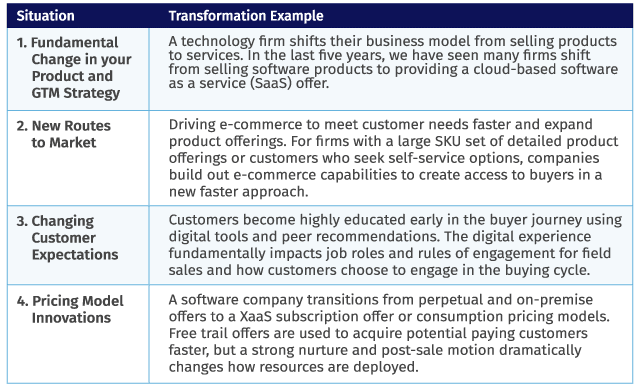Technology: How Business Transformation Changes GTM Planning

A Tech Industry Primer
Annual planning is notoriously known as a taxing exercise on sales and revenue operations. Planning requires significant preparation and proper sequencing of key activities to ensure next year’s plan properly aligns to your firm’s business strategy and associated financial goals. But what happens if your annual planning exercise is concurrent with a newly initiated business transformation? While managing annual planning through a transformation complicates the process, revenue leaders can thoughtfully plan for business transformations within the annual planning process if they know what to look for and have a plan to address increased change management needs that accompany business transformations.
So, where to begin? To answer this question, we’ll explore three key areas:
- What is a go-to-market (GTM) business transformation?
- What go-to-market impacts and considerations should you expect by transformation type?
- What actions are required for successful transformations?
What is a GTM Business Transformation?
Business transformations are bold and fundamental changes to how the organization operates across human capital, processes and technology. Importantly, transformations significantly change how the business operates internally, with customers and/or with partners. Because the change is significant, transformations require an increased level of change management and planning.
To give illustrations of transformations, we identified four typical current situations in the Technology industry.

Addressing GTM Impacts in Annual Planning
Each of the above transformations impact GTM planning with key considerations to address. These impacts can span many areas of planning including resegmentation of customers, changes to coverage model, customer engagement model as well as organizational structure, role design, sales compensation, systems and tools.
Some key examples of these considerations include:
Business Model Shift to a SaaS Offer: Job Roles & Post Sale Focus
The post-sale focus requires additional change management. Use job role redesign and Rules of Engagement to support coverage changes. Gain alignment for how to maximize customer adoption by organizing core AEs and CSMs to collaborate when driving customer value realization. For example, AEs and CSMs should link account business plans to customer success plans. The post-sale changes may need extensive enablement or the addition of specialist resources to help evolve the salesforce to the new selling motions. With the move to a recurring revenue model, determine the right level of core seller focus with renewals and break down key activities involved.
New Routes to Market for E-commerce: Systems, Tools and Proactive Sales Plays
Moving to e-commerce or self-service options for customers increases the need for tools and reporting. Plan for tools and telemetry that will enable job roles to monitor and support high velocity transactions with programmatic support. Consider the need to set up internal resources to provide first line support for self-service customers when issues arise.
Changing Customer Expectations: Buyer Journey, Digital Enablement and Job Roles
Know and monitor the buyer journey and utilize information to create enhanced propensity to buy algorithms. Customers will be more educated on solutions and options by the time a seller has the first call. Leverage enhanced tools for salespeople to understand the customer’s journey and potential needs in advance of initial calls. Sales roles should evolve to be more consultative and provide business value as part of the initial discussion.
Innovation for Consumption Pricing Models: Coverage, Job Roles and Sales Compensation
Shifting to consumption has widespread impacts ranging from sales talent recruitment to sales compensation. If primarily selling to business or functional buyers, consider moving to a bifurcated coverage model. Understand coverage implications and gain alignment on the desired behaviors when deploying different consumption models (pay as you go, committed contracts or uncommitted).
While this is not a comprehensive set of considerations, the point should restate that the effects of transformations are not trivial.
What Actions are Required to Make a Transformation Successful?
- Active Leadership Buy-in, Support and Communication
A transformation is a fundamental change in how you operate, and active top-down engagement and leadership is critical for success. However, it does not stop at the executive level. To successfully navigate the change, your organization will need teamwork and partnership from cross functional leaders down through the organization’s first-line managers to demonstrate a commitment to the organization. Leadership must expect a level of resistance, listen to legitimate issues that aid your change management efforts and stay focused on why the business must transform. Build visibility and alignment across teams with a communication program using a series of cascading messages reenforcing the purpose and strategy, critical operational changes and how each team is directly engaged in the new model. - Increase Change Management Time & Expectations: Plan for more time and sequence the change if required. Seismic shifts in job roles and responsibilities, new skill sets and customer interactions will take the organization more time to absorb than a couple of kick off meetings, training sessions and town halls. An extensive change management plan requires the right tools, frequent checkpoints and discipline to operationalize processes to stay the course. Teams will tend to drift back to the “old way” if management waivers. Have a contingency plan that still drives to the desired end state but provides a release valve if teams begin to overheat from the speed or magnitude of change.
- Establish the Proper Enablement Strategy: Align your enablement strategy and effort to the GTM team requirements for a successful transformation. Pending the magnitude of your changes and the current organizational state, plan to build or update tools, processes, technology and training that will support the new operating model. Rules of engagement will be critical for alignment and scaling of the new GTM plan.
- Plan for Quick Wins to Celebrate Success: Transformations take time, but you cannot wait to complete the journey before logging key wins. To keep momentum with the teams, drive visibility of key milestones, decisions and progress where you celebrate success and quick wins during the transformation.
Identifying a business transformation upfront will enable teams to adjust annual planning steps and alter their approach to mitigate risk with better alignment across teams.
For more information or for help with reviewing transformation needs, contact Alexander Group’s Technology practice to learn learn how we can help.
___________________________________________________
Recommended Insights:
Article: Contemporary Practices for Consumption-Based Businesses
Article: The Hunter/Farmer Model for Driving Growth
Article: Effective Lead Management – Governance and Lead Attribution
Video: 2022 Technology Industry Predictions – Partners & Alliances